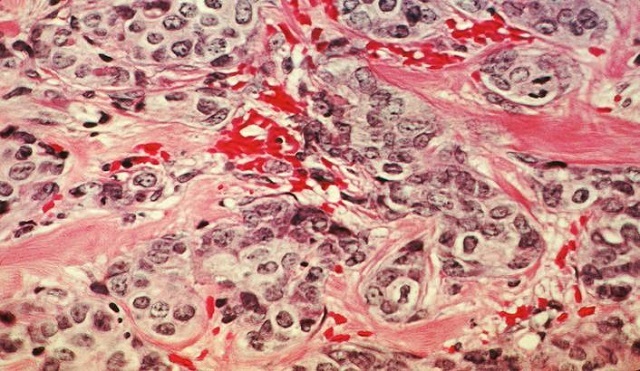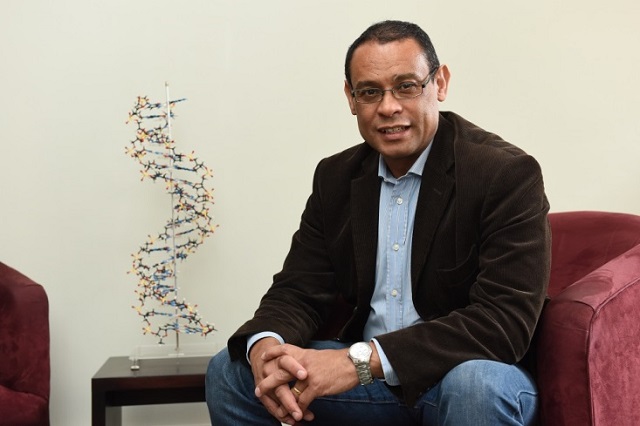Cancer care meets big data: SA's latest treatment breakthrough
22 June 2016 | Story by Newsroom
Two South African chemists have made a breakthrough in cancer research that paves the way for early diagnosis and specialised treatment based on each cancer's unique genetic expression pattern.
Early diagnosis is critical for cancer survival; and the discovery made by Dr Kevin Naidoo, SA Research Chair in Scientific Computing in the Department of Chemistry at UCT, and Dr Jahanshah Ashkani, also of the department, could therefore have a major impact on the prognosis for cancer patients.
The study is published in the latest issue of Scientific Reports.
Their research focused on six common cancer types – breast, colon, lung, kidney, ovarian and brain – and found that each of these has a unique genetic expression pattern that can be used for accurate early diagnosis; and more specifically, for specialised treatment.
How did they do it? Here's where it gets a little complicated. Essentially, they went the 'big data' route, using statistical classification algorithms on large volumes of tumour gene-expression data.
By analysing these vast quantities of data, they found that the GT-expression pattern – or the way in which complex carbohydrates are built – can be used to classify different cancer types early on. Moreover, the expression patterns are specific enough that variations can be identified within each cancer type, which can then guide the treatment route.
The latter finding is also crucial. Just as early diagnosis has a strong influence on the patient's prognosis, so too does the choice of treatment. While older cancer treatments typically killed cancer cells, newer, targeted therapies – which may form part of the treatment regimen, rather than being used in isolation – prevent the proliferation of the cells.
Naidoo and Ashkani's discovery underlines the importance of using computational big data analytics in biomedical sciences and the developing field of personalised medicine.
Naidoo is now leading a multi-laboratory collaboration, which will include scientists in pathology and human genetics at the UCT health sciences campus and the Centre for Proteomics and Genomics Research, to analyse the blood samples of South African patients. The aim is to develop a low-cost gene-expression tool for breast cancer – the most common cancer, affecting South African women – which can form the basis of a routinely-used early-diagnostic process.

Here's what Naidoo had to say about the research's potential for medical science:
Daily Maverick: The GT gene expression pattern of a patient can be used to accurately classify cancer types, which lays the ground for developing an early diagnostic. In layman's terms, what does this mean?
Kevin Naidoo: GT refers to enzymes that build complex carbohydrates. The GT expression patterns tell you how much of the enzymes will be made in cells.
Each of the six cancer types shows a distinct GT gene expression pattern, so much so that they can be identified from the expression patterns of 210 GT genes (i.e. signature genes). An older way of identifying cancer types would be to analyse tumour tissues by physical and optical chemical measures, and then to classify the patient's cancer as one of more than 200 cancer types.
This work was based on the computational analysis of genetic data extracted from tumour samples of 1 893 patients, and stored in a database (The Cancer Genome Atlas, TCGA) in the US. To make this an early diagnostic, our result must be shown to be accurate for blood samples.
We are using this tumour data analytics result to inform our collaborative research with UCT's medical school, and to analyse the GT expression patterns in blood samples of South African patients. For this, we need a large number of patient samples to achieve statistical accuracy.
DM: Can you tell us a little bit more about the six cancer types referred to in the study: was it your intention to focus on these specific cancers, or is it that the available data is only applicable to these six types? In other words, is there potential to expand this research to other cancer types as well?
KN: It was not our intention to study only these six. In fact, we have investigated others separately. We chose these specifically because we could compare our diagnosis against existing clinical diagnoses which were available for the breast cancer samples in the database. It is our intention to expand the research to as many cancer types as possible, given the availability of genomic data.
DM: There is, of course, more than one type of cancer that can affect the above-mentioned six organs, and prognosis differs accordingly. Can this research breakthrough detect, for example, whether a patient is prone to developing a particularly aggressive form of cancer?
KN: Indeed our research does this, and interestingly, this is the most immediate application of our finding. We can detect the specific subtypes of a cancer type, and we have shown this for breast cancer (once again, because of the availability of clinical data that could corroborate our findings). For example, we found distinct patterns for aggressive types of breast cancer, such as what's commonly termed 'triple negative' breast cancer.
DM: Ovarian cancer in particular has been labelled a 'silent killer', because it's so difficult to detect early (worldwide, it is the cancer affecting women that has the lowest survival rate). What will be the potential for early screening here?
KN: We have not started a blood sample study for ovarian cancer, but this will follow once we see positive results for the breast cancer pilot study.
DM: Reference has been made to this research assisting early detection. Ultimately, could it also serve prevention?
KN: Unfortunately, not at the moment. Even early detection of cancer is likely to lead to longer patient survival times, and the accurate identification of subtypes is valuable to the 'precision medicine' approach to patient care.
DM: “The low-cost gene expression tool for breast cancer that will form the basis of a routinely-used early diagnostic”. Can you tell us a bit more? How it will work, and what will it entail?
KN: Upon establishing that the blood GT expression data is an accurate measure of the presence of a cancer type, a low-cost means of extracting the signature genes or part thereof can be developed by expositing genomic technology.
The expression pattern for the GT genes (signature genes) can be computationally analysed for a match against any of the six cancer-GT-expression-unique patterns.
DM: Do you foresee a partnership between, for example, clinicians and funders, where this research can ultimately help achieve more cost-effective cancer care overall?
KN: We have started working with medical researchers over the last year, and we would like to see a partnership between computational data analytics laboratories like ours; clinical and laboratory researchers funded in larger, cohesive efforts, as has been done at major cancer research centres in the United States, Europe and Asia.
DM: Is there anything you would like to add – something you believe is important for researchers, patients and the public to know?
KN: We hope that the field of computational data analytics in biomedicine is able to integrate fully into clinical research in South Africa, as is the world trend. We hope that our research results inspire this structural change in clinical research in South Africa, and that it will lead to the growth and development of 'precision medicine' that is being shown worldwide to result in improved patient care and greater survival times in cancer.
By Marelise van der Merwe, Daily Maverick. Republished with kind permission. Image of Kevin Naidoo by Michael Hammond. Image of cancer cells courtesy of National Cancer Institute.
 This work is licensed under a Creative Commons Attribution-NoDerivatives 4.0 International License.
This work is licensed under a Creative Commons Attribution-NoDerivatives 4.0 International License.
Please view the republishing articles page for more information.











